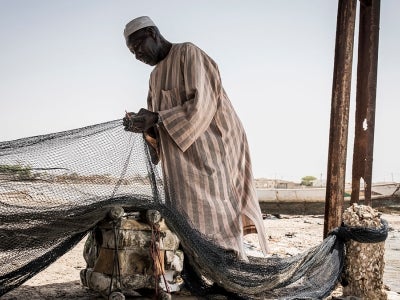
Sea cucumbers are dried to send to China.
Diver Ulrich Banboche packed the schooner on a recent morning to go out to sea in search of sea cucumber. To catch these prized bottom feeders, the 29-year-old will plunge 30 to 35 meters down in the warm opal waters of the South West Indian Ocean.
Sea cucumber, the small vacuum cleaners of the sea floor, are distant relatives of starfish. They have been pursued by divers in the Seychelles for more than 100 years, with reports of exports from the late 1800s. The creatures are highly prized as delicacy, folk remedy, and aphrodisiac, especially in Asia. For most of the 20th century, the sea cucumbers could be found just off the shore and reefs, and the quantities fished were sustainable. But over the past two decades, sea cucumber fishing has developed rapidly in the Seychelles, mostly due to high demand on the international market, especially from China, leading to overexploitation of stock.
Sea cucumber catches taken in Seychelles waters peaked in 2012, and since then they have declined steadily. A recent sea cucumber stock assessment, supported by the World Bank-funded South West Indian Ocean Fisheries Governance and Shared Growth Project (SWIOFish), resulted in the introduction of quotas. The World Bank-funded effort aims to arrest further declines and prevent the rapid collapse that is common to these fisheries globally. Financed by the World Bank's IDA Fund, the Global Environment Facility, and other partners, SWIOFish aims to support countries maintain or increase priority fish stocks and the benefits that they can provide, with a focus on benefits for poverty reduction and food security.
The significant filtering role that sea cucumbers play in the increasingly fragile ocean ecosystems is only beginning to be understood. They can be found feeding, or vacuuming the sea floor off Seychelles’ island shores —though not in the copious numbers of a quarter century ago. Dr. Iria Fernandez-Silva, a fellow at the California Academy of Sciences, said that these invertebrates “are superstar ocean cleaners that are hugely important to marine ecosystems,” adding that it is worth protecting their numbers for their ocean housekeeping alone. (About 16 species of sea cucumber are considered threatened with extinction by the IUCN in 2014)
The sea cucumber species that are the most prized in Asia—flower teat, white teat, and prickly red—are also overexploited and endangered. Once the catches have peaked and are on a downward trajectory, it is unlikely that management interventions, other than complete closure of the fishery, can rebuild stocks since reproduction is already greatly impaired.
In Seychelles, SWIOFish supported the Seychelles Fishing Authority to strengthen the sea cucumber co-management advisory committee with improved data collection and collaboration with skippers and divers for the more recent assessment with buy-in from the fishing community. SWIOFISH projects are also supporting the fisheries of Madagascar, Seychelles and Maldives, Comoros, Tanzania and Mozambique.
In the Deep with the Sea Cucumber Diver
Banboche took his first dive for cucumber when he was 11, and has been diving regularly for work since he was 16. He said that these days, everyone in Seychelles, including the divers, accept the need for a closed season, which recently has been increased from three months to four, based on SWIOFish recommendations. This closure is part of a suite of management measures that aim to control fishing pressure, including limits to the number of licenses issued to fish sea cucumber and the recently introduced quota-based system.
“It takes a lot of concentration to find the cucumbers,” Banboche said. He is loading rice for four divers and two crew members to last weeks on the boat as he talks about his skills. “I have gained a professional instinct. It tells me where to work.” Banboche also says that over time, he has learned to dive deeper and stay out on the boat longer: “Sometimes I am under water 30 to 35 minutes, other times 45 minutes to an hour. After one dive, I have to rest, for at least one hour.” He may plan to stay out 20 to 25 days, but then remain longer.
SWIOFISH supports the training of divers to reduce accidents, and introduced mandatory medical testing of divers, many of whom have used drugs, especially opioids, to dull pain and boredom, according to divers and fishery specialists. All divers are now insured. Recommendations include: no more than three dives a day, diving in pairs, no drugs or alcohol (drug abuse among divers can be prevalent), no yo-yo diving (up and down) and no stressful lifting after diving.
Still, the work is difficult and many divers suffer decompression accidents or lost limbs to sharks, studies show. Diver Banboche said that his wife demanded that he stop this year, after 13 years of diving, and take up less adventurous fishing off the schooner. His two young daughters, Sharifa, 9, and Murline, 5, agree with her.
“I am gone too long sometimes,” he said. “It’s true I can’t do this forever.”
This story was originally published by World Bank.


